Reticulated python
Malayopython reticulatus
These popular pets can get big enough to kill their owner.
Advertisement
Reticulated python Scientific Classification
- Kingdom
- Animalia
- Phylum
- Chordata
- Class
- Reptilia
- Order
- Squamata
- Family
- Pythonidae
- Genus
- Malayopython
- Scientific Name
- Malayopython reticulatus
Read our Complete Guide to Classification of Animals.
Reticulated python Conservation Status
Reticulated python Facts
- Prey
- Anything it can overpower. It prefers mammals and birds.
- Name Of Young
- Neonates, hatchlings
- Group Behavior
- Solitary except during mating season
- Fun Fact
- These popular pets can get big enough to kill their owner.
- Biggest Threat
- Habitat destruction
- Other Name(s)
- Ngu luam (Thai)
- Litter Size
- 15-80
- Lifestyle
- Nocturnal
- Common Name
- Reticulated python, Retic
- Nesting Location
- Ground
Reticulated python Physical Characteristics
- Color
- Brown
- Grey
- Yellow
- Fawn
- Black
- White
- Tan
- Albino
- Dark Brown
- Cream
- Orange
- Chocolate
- Olive
- Skin Type
- Scales
- Lifespan
- 25+ years
- Length
- Typically 13-20 feet long at maturity
- Age of Sexual Maturity
- 2-5 years
- Venomous
- No
- Aggression
- High
View all of the Reticulated python images!
The reticulated python is the world’s longest snake and is a nonvenomous constrictor native to Southeast and South Asia.
These are big, beautiful snakes, and just because they’re nonvenomous doesn’t make them not dangerous in the wrong hands. These snakes are one of the few with actual accounts of them having eaten humans.
Incredible Reticulated Python Facts
- The longest reticulated python living is said to be over 25 feet long.
- It’s an excellent swimmer, and many people have reported seeing one far out into the ocean.
- In at least two reported cases, an adult human was eaten by a reticulated python.
- They were among the first species to colonize Krakatau when it emerged.
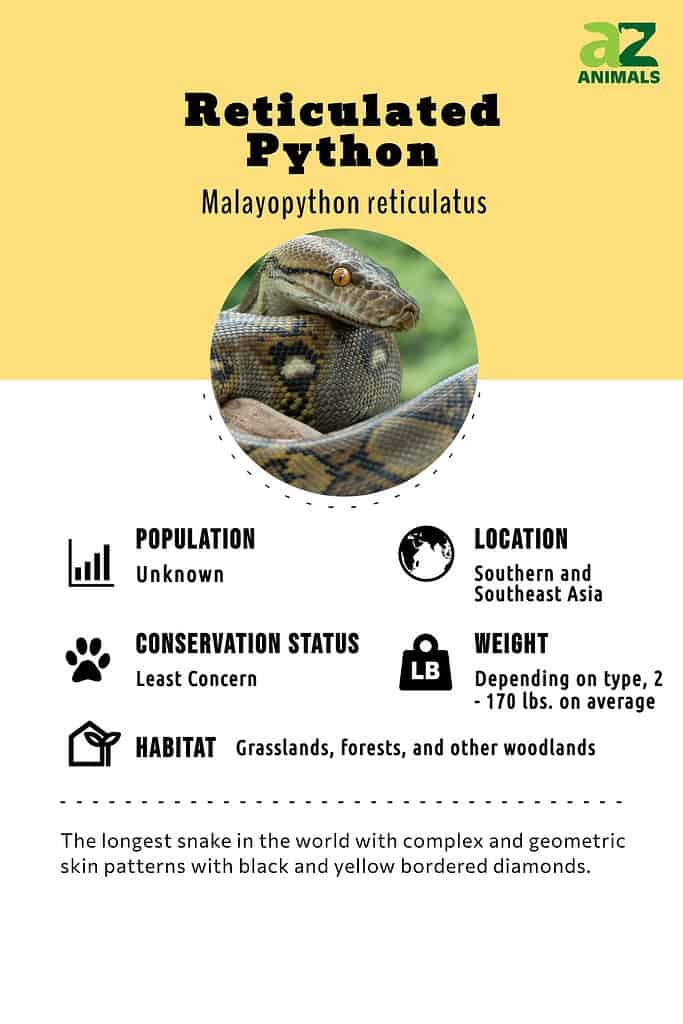
Scientific Name and Classification
Reticulated pythons are members of the family Pythonidae, cousins to snakes like the Burmese python, ball python, and green tree python. Their scientific name is Malayopython reticulatus. The genus, Malayopython, refers to its morphological and genetic status as a sister species to those of the Python genus. Reticulatus is its specific name and describes its markings and color pattern, which are “net-like.”
The genus name is the subject of some controversy.
In 1801, Johann Gottlob Theaenus Schneider, a German naturalist, described two specimens that were located in the Göttingen Museum. He believed they were different species because their patterns were a little different from one another. Schneider called them Boa rhombeata and Boa reticulata.
In later years reticulated python was variously reclassified as Python reticulatus, Constrictor schneideri, and Python schneiderii. The early 2000s saw more classification changes for this species as genetic research was completed. Scientists proposed several other genus names, including Broghammerus and Python.
However, the International Code of Zoological Nomenclature accepted Malayopython reticulatus as its scientific name and left Python reticulatus and Boa reticulata as synonyms. So, until something else comes to light, that’s likely where it will stay.
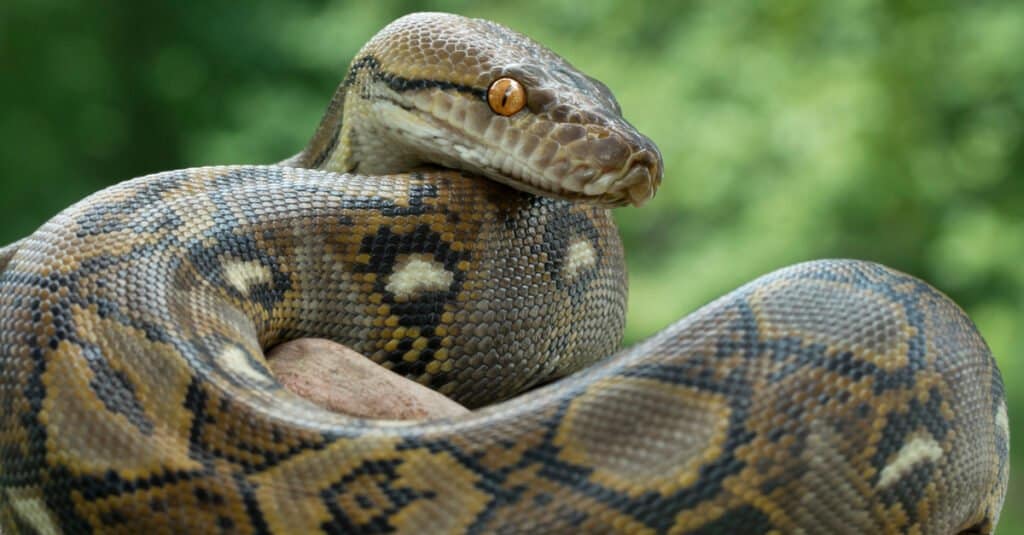
is its specific name and describes its markings and color pattern, which are “net-like.”
©Mark_Kostich/Shutterstock.com
Types
These snakes come in a wide variety of color patterns, and many of the variations can be based on their location. However, there are three subspecies, and two of them are dwarf species that occur on islands.
- Asiatic Reticulated Python (M. r. reticulatus) – This is the nominate subspecies and the one holding the longest snakes.
- Kayaudi or Tanahjampean Reticulated Python (M. r. jampeanus) – You’ll find this subspecies south of Sulawesi, on Tanahjampea in the Selayar Archipelago. It’s a dwarf subspecies and only reaches half the length of the Asiatic reticulated python.
- Selayar Reticulated Python (M. r. saputai) – Inhabits Selayar Island and nearby Sulawesi. It’s also a dwarf subspecies.

Reticulated pythons are named for their pattern of interlocking diamonds.
©Nynke van Holten/Shutterstock.com
Appearance
Individuals of this species hold records for the longest snake in the world and one of the top three heaviest snakes. Snakes are notoriously difficult to measure, so even though there have been reports of individuals exceeding 30 feet, those have never been verified. However, the longest scientifically measured reticulated python was 22 ft, 10 in, and weighed 130 pounds after not eating for almost three months. According to the Guinness Book of World Records, the longest-living snake is a reticulated python named Medusa, kept by its owner in Kansas City, Missouri. In 2011, Medusa reportedly measured 25 ft 2 in and weighed over 350 pounds.
However big they can get, the truly large are very rare; most reticulated pythons don’t exceed 20 feet long.
The reticulated python is a heavy-bodied, very long snake with a proportionately large head. Like most other python species, it has heat-sensing pits. The pits are deep and well-developed, located on the front upper and lower labials and the lower rear labials. Its eyes are usually orange or orange-red, and it has vertical pupils.
Their color pattern is geometric and quite complex. Along the center of its back, there are black and yellow bordered diamonds, and on its sides are smaller shapes that can vary from oval to triangular with lighter colored centers. The head of most reticulated pythons has a stripe that starts just behind its nose and continues to the neck. There are also dark stripes that start behind the eyes and extend downward toward the back of the jaw. The belly is usually lighter colored and varies from cream to yellow-orange. Across the reticulated python’s wide geographic distribution, the color pattern varies considerably.
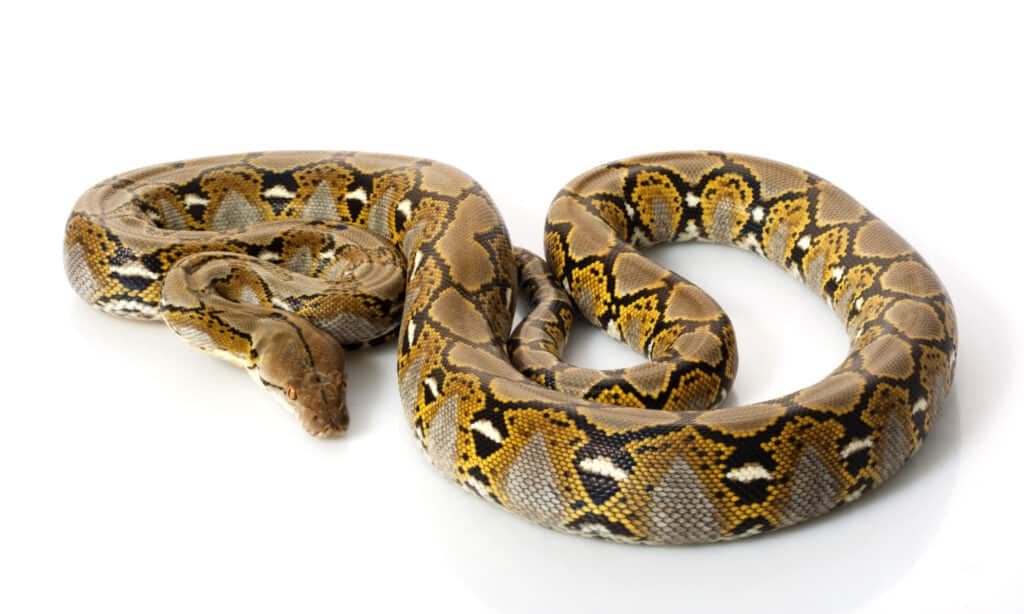
This reticulated python shows the dorsal line beginning right behind its nose and the net-like appearance of its markings.
©fivespots/Shutterstock.com
History and Evolution
Snakes’ and pythons’ ancestors were actually reptiles with legs that looked similar to lizards. They were also other aquatic reptiles. Over time, these animals found less and less use for their legs, and over millions of years, they evolved without their legs, or they became vestigial. This is probably due to the advantages of being very close to the ground and, therefore, close to their prey.
Pythons were previously classified with boas, but modern research has shown that the pythons and boas are separate species due to convergent evolution in different parts of the world, much like monkeys evolved differently in Africa and South America while having shared ancestors. Some of the major differences are that boas give birth to live young, and pythons lay eggs. Pythons also have their heat-sensing pits on their labial scales, and boas have them in between their labial scales.
Reticulated Pythons also being very good swimmers very well could have allowed them to relocate to other lands and islands early on in their history. Then, they evolved into different subspecies depending on their new environments.
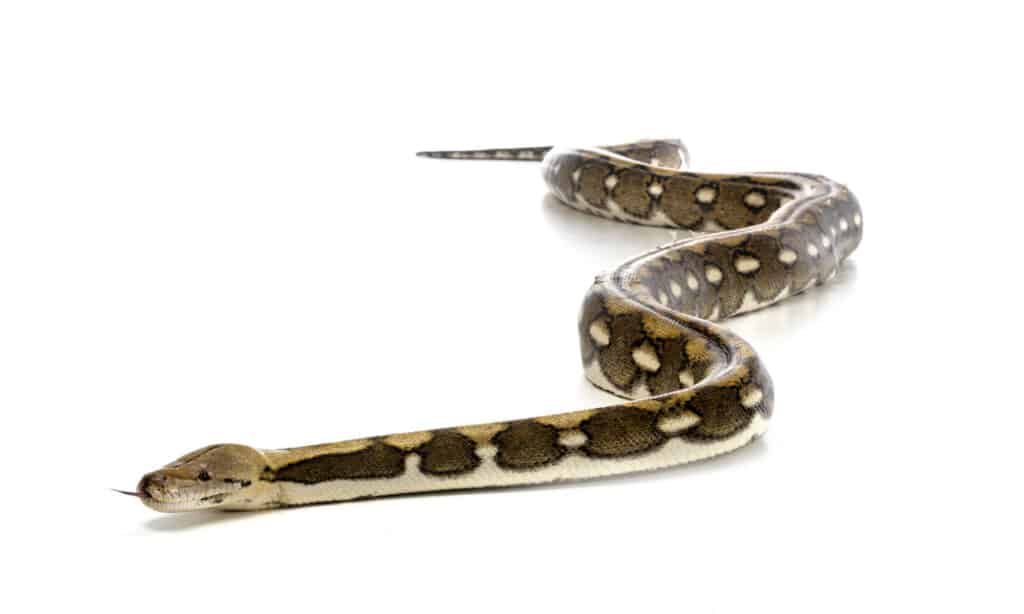
Reticulated pythons are excellent swimmers.
©cynoclub/Shutterstock.com
Behavior
This species, despite its striking color patterns, camouflage well within its environment. It’s an example of disruptive coloration, a type of camouflage where the animal’s pattern helps break up the outlines of its body. This pattern helps this giant snake disappear into the brush and allows it to ambush its prey.
Reticulated pythons live most of their lives alone. Being solitary creatures makes ambushing their prey much easier. Like all pythons, this snake prefers to lie in wait until something tasty crosses its path. It has large teeth that can measure up to an inch long. These teeth, combined with strong jaws and a muscular body, make this snake a deadly predator. It kills by constriction and then swallows its prey whole. This is a fairly aggressive snake in the wild and hisses loudly when someone disturbs it.
The reticulated python is one of the few snakes that is confirmed to prey on humans. This fact is part of what prompted the U.S. Government to add it to the list of banned imports in the Lacey Act.
Those who keep reticulated pythons as pets don’t always handle larger snakes often because they can be difficult to work with because of their size. It’s illegal to own one of these in some states without a permit.
Habitat
These snakes are common throughout much of Southeast Asia, including Bangladesh, Cambodia, Myanmar, Laos, Thailand, Vietnam, Malaysia, and Singapore. They also occur in Indonesia and the Philippines. There’s one recorded individual found on mainland India, but it doesn’t appear to have been part of a breeding population there.
Reticulated pythons inhabit woodlands and adjacent grasslands and rainforests; it often stays near rivers and lakes. Some people have reported finding them in the sewers in Singapore, Indonesia, and Borneo. The species’ swimming capabilities are excellent, and it has been able to colonize many small islands within its range. When Krakatau emerged, it was one of the first species to colonize the new island.
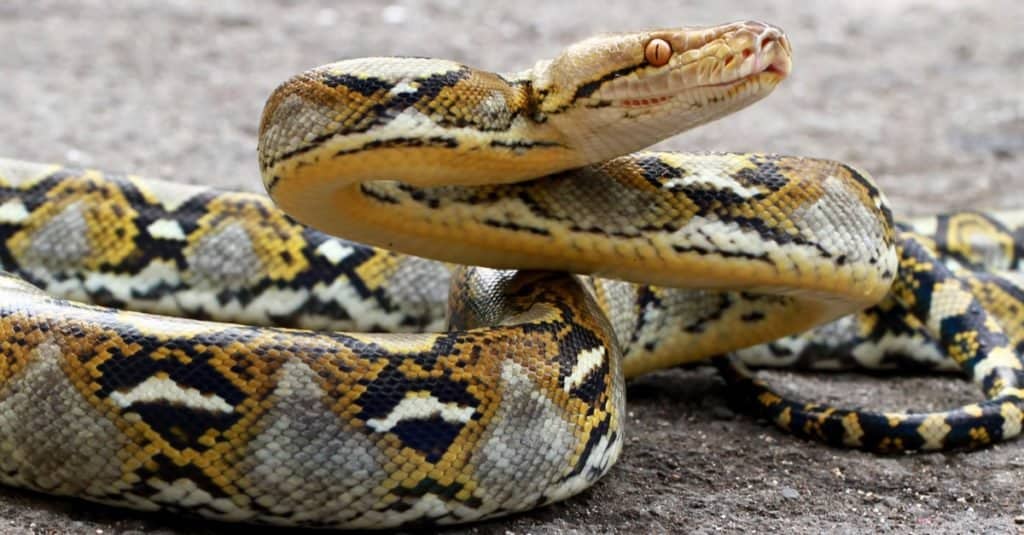
Reticulated pythons inhabit woodlands and adjacent grasslands and rainforests; it often stays near rivers and lakes.
©Opayaza12/Shutterstock.com
Diet
This snake’s diet normally includes a variety of mammals and birds. Smaller individuals, up to about 9-13 feet long, mostly eat rats, other rodents, bats, and treeshrews. As they grow, reticulated pythons switch to bigger prey such as the Indian civet, binturong, various primates, slow lorises, deer, and pigs. Pythons that live near villages and cities also take stray cats, dogs, and chickens.
Even though this snake can get large enough to swallow an adult human, the shoulder width of some people can pose a problem for the snake. Even with the problem of shoulder width, these snakes have gone into forest huts and taken small children.
Verified Attacks on Humans
Although attacks are rare, there are some well-documented instances. Here are a few:
- In 2013, a python killed a security guard near a hotel in Bali.
- A 13-foot pet python in Virginia Beach, Virginia, killed its owner when she tried to give it medication.
- A 23-foot python was found with the body of a missing 54-year old woman in its stomach.
- Another 23-foot python swallowed a 25-year old man.
Predators, Threats, and Conservation
Throughout most of their natural range, they’re common. The IUCN Redlist of Threatened Species lists them as “Least Concern.” However, there are some pockets where habitat destruction and over-harvesting for food, skin, and the pet trade may have reduced their numbers. These snakes have few natural predators as adults. However, the juveniles are eaten by various birds of prey and carnivorous mammals; in addition, local tribes often eat them as part of their diet.
Even in those areas where people have actively hunted reticulated pythons for food or in the pet trade, the numbers don’t seem to be decreasing. The snake reproduces easily and matures at a young age. Of course, due to the difficulty in counting snake populations, it’s possible that their population is more fragmented than we realize as yet.
Reproduction, Babies, and Lifespan
The only time they’re likely to be around another of their own species is during mating season, which is during February and March. Reticulated pythons live most of their 25+ year lifespan alone. During mating season, the females release pheromones that attract males to them. Often, the female mates with multiple males during a single mating season.
After breeding, the female finds a snug place on the ground to lay 15-80 eggs. She will stay coiled around them until they hatch. Assuming an ideal temperature of 88-90 degrees, the eggs hatch approximately 88 days later. Neonates generally measure at least two feet long when they hatch; they are independent when they leave the egg and mature in 2-5 years.
Similar Animals
- The Burmese Python is also really big. And it’s got a breeding population in southern Florida that’s wiping out native wildlife.
- Rock Pythons are native to Africa and can weigh over 200 pounds.
- Blood Pythons have beautiful reds in the color pattern, which is where they get the name blood python.
Reticulated python FAQs (Frequently Asked Questions)
Are reticulated pythons aggressive?
Yes, these are among the more aggressive of the pythons.
Can a reticulated python eat a human?
Yes, and it’s one of the few examples of a snake being large enough to do so – combined with documented accounts of it happening.
Why is it called a reticulated python?
It’s their pattern! Reticulated is from a Latin word that means “net-like.” The complicated geometric pattern this species exhibits often resembles a network of interlocking shapes.
What do reticulated pythons eat?
In the wild, they eat whatever they can overpower and swallow. In captivity, most people feed them rats, mice, chickens, and rabbits.
Is a reticulated python a good pet?
That depends. Do you have the space and money to set up a proper enclosure? Do you have the experience and friends to help you handle what will become a 15-foot-long tube of muscle? If you’re unsure about any of those things, a ball python is probably a better choice.
Thank you for reading! Have some feedback for us? Contact the AZ Animals editorial team.
Sources
- Integrated Taxonomic Information System, Available here: https://www.itis.gov/servlet/SingleRpt/SingleRpt?search_topic=TSN&search_value=1094041#null
- Reticulated Python | IUCN Redlist of Threatened Species, Available here: https://www.iucnredlist.org/species/183151/1730027
- Reticulated Python | Reptile Database, Available here: https://reptile-database.reptarium.cz/species?genus=Malayopython&species=reticulatus
- Predators and Competitors | Cornell Chronicle, Available here: https://news.cornell.edu/stories/2011/12/primates-prey-predators-and-competitors-snakes

















